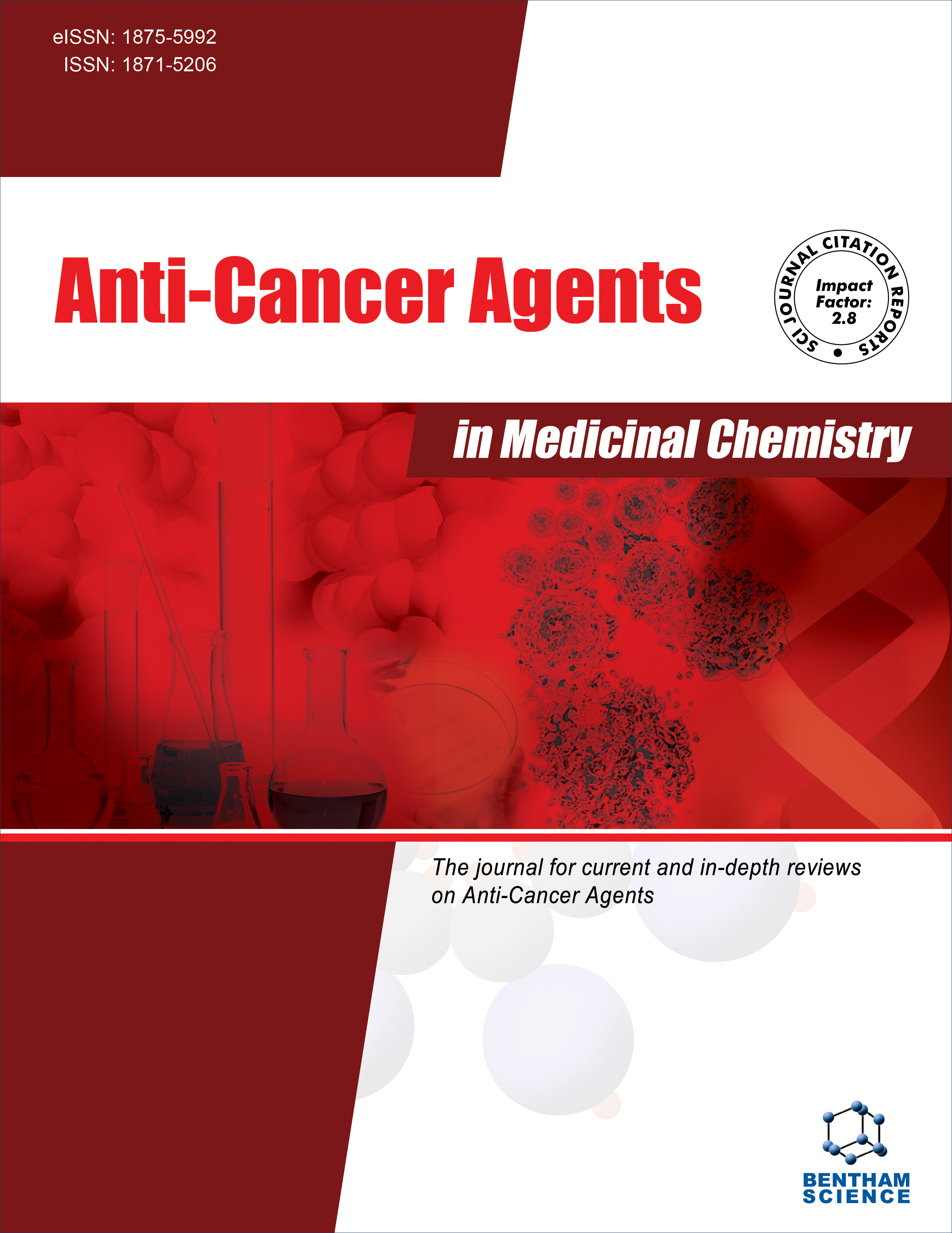- Home
- A-Z Publications
- Anti-Cancer Agents in Medicinal Chemistry (Formerly Current Medicinal Chemistry - Anti-Cancer Agents)
- Previous Issues
- Volume 11, Issue 4, 2011
Anti-Cancer Agents in Medicinal Chemistry (Formerly Current Medicinal Chemistry - Anti-Cancer Agents) - Volume 11, Issue 4, 2011
Volume 11, Issue 4, 2011
-
-
Editorial [Hot Topic: SOD Enzymes and Their Mimics in Cancer:Pro- vs Anti-Oxidative Mode of Action-Part II (Guest Editor: Ines Batinic-Haberle)]
More LessAs a continuation of Part I, herein Garry Buettner [1] addressed the critical role of manganese superoxide dismutase, MnSOD - the enzyme that we cannot live without. MnSOD is a central player in the redox biology of cells and tissues [1]. It is critical for establishing the appropriate balance in redox circuitry of the mitochondria. Thus, there has been an increasing demand to develop powerful SOD mimics. In the studies where Read More
-
-
-
A Combination of Two Antioxidants (An SOD Mimic and Ascorbate) Produces a Pro-Oxidative Effect Forcing Escherichia coli to Adapt Via Induction of oxyR Regulon
More LessAuthors: Ines Batinic-Haberle, Zrinka Rajic and Ludmil BenovCationic Mn(III) N-alkylpyridyl (MnTalkyl-2(or 3)-PyP5+) and N, N'-dialkylimidazolylporphyrins (MnTDalkyl-2-ImP5+) have been regarded as the most powerful SOD mimics/peroxynitrite scavengers - i. e. antioxidants. The ethyl-, MnTE-2-PyP5+ (AEOL10113), and hexylpyridyl-, MnTnHex-2-PyP5+ and diethylimidazolylporphyrin, MnTDE-2-ImP5+ (AEOL10150) have been mostly studied in vitro and in vivo. Given the in vivo abundance Read More
-
-
-
Superoxide Dismutase in Redox Biology: The Roles of Superoxide and Hydrogen Peroxide
More LessSuperoxide dismutases (SOD) are considered to be antioxidant enzymes. This view came about because its substrate, superoxide, is a free radical; in the era of their discovery, 1960's - 1970's, the general mindset was that free radicals in biology must be damaging. Indeed SOD blunts the cascade of oxidations initiated by superoxide. However in the late 1970's it was observed that cancer cells that have low activity of the Read More
-
-
-
Nitroxides as Cancer Imaging Agents
More LessAuthors: Ryan M. Davis, James B. Mitchell and Murali C. KrishnaNitroxides are low molecular weight (150-400 Da) superoxide dismutase mimics that exhibit antioxidant, radical scavenging, and radioprotective activity. Additionally, the paramagnetic nature of nitroxides makes them viable as both spin probes for electron paramagnetic resonance imaging as well as contrast agents for magnetic resonance imaging. These imaging techniques enable in vivo monitoring of nitroxide metabolis Read More
-
-
-
Salen Mn Complexes Mitigate Radiation Injury in Normal Tissues
More LessSalen Mn complexes, including EUK-134, EUK-189 and a newer cyclized analog EUK-207, are synthetic SOD/catalase mimetics that have beneficial effects in many models of oxidative stress. As oxidative stress is implicated in some forms of delayed radiation injury, we are investigating whether these compounds can mitigate injury to normal tissues caused by ionizing radiation. This review describes some of this research, focusin Read More
-
-
-
Anti-Cancer Activity of Nitrones and Observations on Mechanism of Action
More LessAuthors: Robert A. Floyd, Hema K. Chandru, Ting He and Rheal TownerThe nitrone compound PBN, α-phenyl-tert-butylnitrone, and closely related nitrones have anti-cancer activity in several experimental cancer models. The three experimental models most extensively studied include A) the rat choline deficiency liver cancer model, B) the rat C6 glioma model and C) the mouse APCMin/+ colon cancer model. The two PBN-nitrones mostly studied are PBN and a PBN derivative 2,4-disulfop Read More
-
-
-
Cellular Uptake and Organ Accumulation of Amphipolar Metallocorroles with Cytoprotective and Cytotoxic Properties
More LessAuthors: Zoya Okun, Lana Kupershmidt, Moussa B. H. Youdim and Zeev GrossWe report here an investigation that focuses on the organ distribution of metal complexes that are chelated by the amphipolar corrole whose macrocycle is decorated by two sulphonic acid head groups, which are emerging potential therapeutics against cancer (the cytotoxic Ga chelate) and diseases that are characterized by excessive production of ROS and RNS (the cytoprotective Mn and Fe derivatives). We show that t Read More
-
-
-
Bioactive Sphingolipids in Response to Chemotherapy: A Scope on Leukemias
More LessAuthors: Huseyin Atakan Ekiz and Yusuf BaranSphingolipids are major constituents of the cells with emerging roles in the regulation of cellular processes. Deregulation of sphingolipid metabolism is reflected as various pathophysiological conditions including metabolic disorders and several forms of cancer. Ceramides, ceramide-1-phosphate (C1P), glucosyl ceramide (GluCer), sphingosine and sphingosine-1-phosphate (S1P) are among the bioactive sphingolipid species that ha Read More
-
-
-
Molecular Mechanisms of Anti-cancer Action of Garlic Compounds in Neuroblastoma
More LessAuthors: Surajit Karmakar, Subhasree Roy Choudhury, Naren L. Banik and Swapan K. RayThe medicinal properties of garlic (Allium sativum) have been well known and widely used since historical times. Garlic compounds have received increasing attention during the last few years due to their cancer chemopreventive properties. The anti-cancer activity of garlic-derived organosulfur compounds (OSCs) are extensively reported in many cancers but only a few in the pediatric tumor neuroblastoma, which Read More
-
Volumes & issues
-
Volume 25 (2025)
-
Volume 24 (2024)
-
Volume 23 (2023)
-
Volume 22 (2022)
-
Volume 21 (2021)
-
Volume 20 (2020)
-
Volume 19 (2019)
-
Volume 18 (2018)
-
Volume 17 (2017)
-
Volume 16 (2016)
-
Volume 15 (2015)
-
Volume 14 (2014)
-
Volume 13 (2013)
-
Volume 12 (2012)
-
Volume 11 (2011)
-
Volume 10 (2010)
-
Volume 9 (2009)
-
Volume 8 (2008)
-
Volume 7 (2007)
-
Volume 6 (2006)
Most Read This Month
Article
content/journals/acamc
Journal
10
5
false
en


